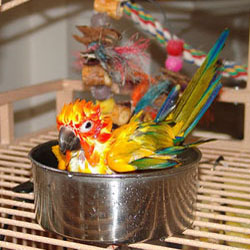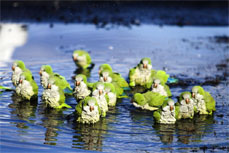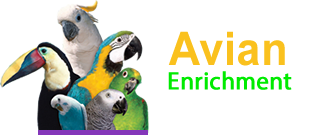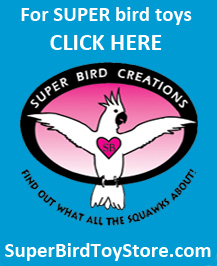
 In the wild, all birds bathe regularly to ensure their feathers are maintained in tip-top flight condition. Bathing stimulates preening which removes dirt, dander and unwanted visitors from feathers. Parrots have been observed getting their baths during rainstorms, splashing in puddles or streams, rubbing against leaves that condense moisture in the high humidity tropical environment and by taking dust baths when water is not plentiful.
In the wild, all birds bathe regularly to ensure their feathers are maintained in tip-top flight condition. Bathing stimulates preening which removes dirt, dander and unwanted visitors from feathers. Parrots have been observed getting their baths during rainstorms, splashing in puddles or streams, rubbing against leaves that condense moisture in the high humidity tropical environment and by taking dust baths when water is not plentiful.
Each individual parrot has its own preference when it comes to bathing. Figuring out just what that preference is can sometimes be a challenge but don't give up by thinking "my bird hates baths". Providing your bird with daily bathing opportunities is another essential ingredient in keeping your bird healthy and beautiful. Besides the obvious benefit bathing has on feather condition it also helps to keep dander levels down and it is good for your bird's skin and respiratory health as the moisture and humidity helps to maintain sinus and nasal passage health.
Here are some ways that your bird might like to bathe:
- Wading: Many birds are pool bathers and love to splash around in shallow water. Try a birdbath, bowl or pan of water no higher than your bird’s legs, placed at the bottom of its cage. Some bird's even love to bathe in a sink with the water running gently.
- Misting: Most birds prefer a gentle falling mist like spray. Point the mister in a fashion that allows the water to fall down gently like rain. Be careful not to spray directly into the face as this is uncomfortable and may frighten your bird.
- Showering: Many birds like the sound of running water and the larger drops of a shower. Shower perches are available that provide non-slip surfaces for your bird to grip. A few hints about showering:
- Try showering with your bird and have a fun time together "singing in the rain."
- Place the perch off to the side not directly under the spray.
- Allow your parrot time to adapt to the shower on its perch while it observes you shower.
- Gradually introduce your parrot companion to the water.
- Rolling in Leaves: For small birds, try placing wet lettuce leaves or large leafy green vegetables at the bottom of their cage. Many small birds love to roll in the leaves and get some good nutrition at the same time.
A few other tips related to bathing:
- Bathe daily if possible or at least a minimum of three times per week. Bathing promotes healthy skin and feathers.
- Bathe more frequently in dryer months to maintain a healthy respiratory system. Our winter heating systems result in very low indoor humidity levels which are unhealthy for our birds.
- Bathe your parrot companion during the warmest part of the day so the bird will dry before the temperature falls.
- Always use luke warm to slightly cool water to avoid burns or shocking your bird's system.
- Never drench your bird’s feathers because they can lose precious body heat.
- Make a game of bathing time. If you are enjoying yourself, your bird will likely enjoy himself. In our house we always sing the made up song "It's Birdie Bathy Time" (sung to the old time favorite Ta-ra-ra Boom-de-ay) inserting each bird's name as we move from cage to cage with the mister. Everyone including mom ends up dancing and having a good time.
- Many birds are instinctually stimulated into bathing activity by the sound of a vacuum running. Perhaps the sound is reminiscent of a rainstorm in the tropics?
- If you have an outdoor aviary, an outdoor misting system is a great alternative on a warm sunny day.
- If your bird really gets soiled or greasy you may want to use a bird safe shampoo to help restore your bird's feathers. Consult with your avian vet on the best way to proceed depending on the contaminant and always read the product label and follow the instructions provided.
- Avoid human bathing and shampooing products as they can strip the special preening oils your bird possesses.
- Some birds love getting a blow dry after taking a bath but it's not necessary or even recommended. Make sure that the temperature setting on the hair dryer isn't too high.
- If using a birdbath, pan or bowl of water in your bird's cage, remove it when the bathing is complete and replace any wet cage bedding below to prevent mold growth.



















































































































































Comments powered by CComment